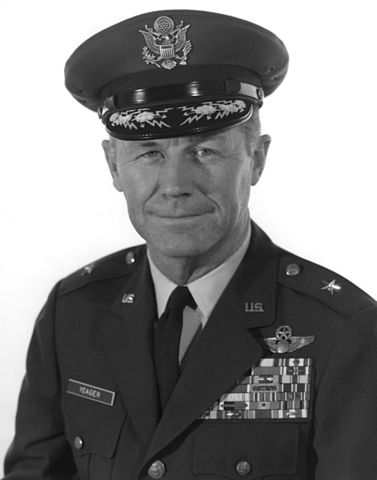*Image Credit: Wikimedia Commons Three years after development of the Bell X-1 began, test pilot Chuck Yeager strapped into the seat for a date with history. Dropped from the belly of a B-29 Superfortress on October 14, 1947, the rocket-powered X-1 became the first aircraft to break the sound barrier in level flight, reaching 807.2mph over the skies of Southern California before returning safely to earth. The idea to create a supersonic craft first came up during the latter stages of World War II. Two interested agencies, the United States Army Air Force and the National Advisory Council for Aeronautics (a forerunner of NASA), decided to test the limits of what could be accomplished in powered flight. The Air Force and NACA, noticing the power of German V-2 rockets terrorizing London, took the idea for a “bullet with wings” to Bell Aircraft in 1945. Working with the best experts the American military and Bell had to offer, a design came together for what amounted to a glider with a rocket tucked in the back. Unsteady at low speeds, the airframe received the modification of a single tail fin jutting straight up near the propulsion nozzle. Afraid the shock of moving at such a high speed might cause the plane to disintegrate in mid-air, engineers looked for ways to keep the X-1 stable without adding too much weight. (This would be the only major alteration to the outside of the aircraft.) By early 1946, the X-1 was ready to be tested. Released high above Pinecastle Army Airfield in Florida, test pilot Jack Woolams completed a number of successful glides controlling the sleek aircraft. Minor changes were made with each run before the Army Air Force Flight Test Division, impatient and looking for results, cancelled the contract with Bell and moved the plane under NACA’s umbrella. The military was determined to see the record achieved sooner rather than later. On the far side of the country, the Air Force had a program at Muroc Army Air Field officials believed would help jumpstart the chase for the sound barrier. On the grounds of what is now Edwards Air Force Base, a decorated World War II pilot by the name of Captain Chuck Yeager was flying the newest aircraft the service had to offer. With 11.5 confirmed kills in the skies over Germany, he earned the title of “Double Ace” and secured one of the first wins over a jet fighter — he seemed a natural choice for the task of surpassing the speed of sound. Officially known as XS-1 Flight 50, the mission on October 14, 1947 was simple: burn the engines hot and see how fast he ended up going. Hiding broken ribs sustained in a fall two days earlier, Yeager locked himself into the X-1 and waited as Glamorous Glennis — named after his wife — was carefully rigged into the bomb bay of the massive B-29. Once the lumbering bomber reached an altitude of 23,000 feet, it released the orange aircraft. Clear of the mother plane, Yeager engaged the four-tube rocket engine and pushed the X-1 to 43,000 feet. Within minutes, he had reached Mach 1.06 and blown past the sound barrier of 770mph. The record achieved and fuel spent, Yeager gently guided the aircraft to a stop on the runway below. Two months later, the story reached the pages of Aviation Week and The Los Angeles Times. The Air Force’s secret was out. Over the course of the next two decades, Yeager would continue to test out aircraft before moving on to command higher positions within the Air Force. The experimental projects division he had been a part of, however, was just getting started. With a blueprint on how to make such groundbreaking work possible, NACA and the Air Force began to push the limits even further. Using information obtained from the first supersonic flight and subsequent trials, engineers were able to change the way aircraft were designed, giving rise to fighter jets capable of sustaining higher speeds. And, as the years progressed, the data would be applied in a far more challenging quest: putting a man on the moon. Also On This Day: 1322 – Robert the Bruce of Scotland defeats King Edward II of England and wins independence 1773 – The Commission of National Education, the first body of its kind, is formed in Poland 1926 – Winnie-the-Pooh is published for the first time 1962 – The United States notices Soviet missiles being installed on Cuba, starting the Cuban Missile Crisis 1994 – Yasser Arafat, leader of Palestine and Israeli leadership, Prime Minister Yitzhak Rabin and Foreign Minister Shimon Pires, receive the Nobel Peace Prize for the Oslo Accords
October 14 1947 CE – Chuck Yeager Pilots the Bell X-1 Beyond the Speed of Sound
*Image Credit: Wikimedia Commons Three years after development of the Bell X-1 began, test pilot Chuck Yeager strapped into the seat for a date with history. Dropped from the belly…
679
